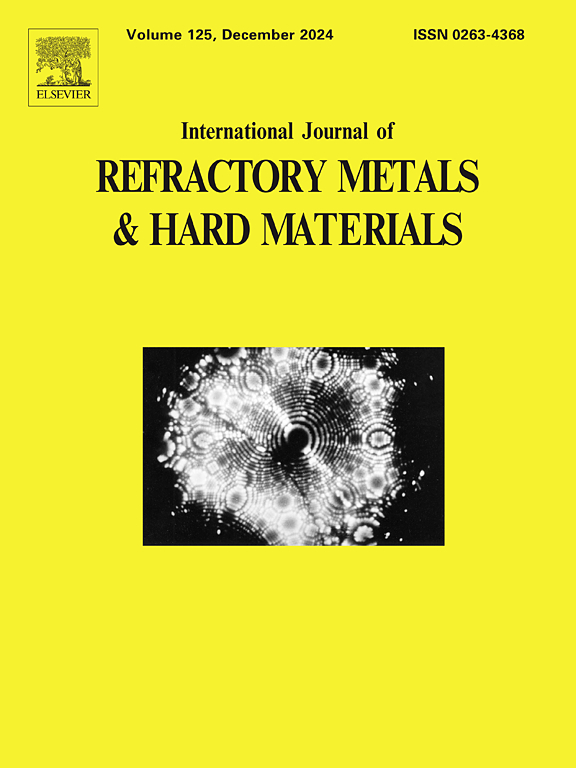揭示了重熔突起在激光织构基底上TiN涂层摩擦学行为中的作用
IF 4.6
2区 材料科学
Q2 MATERIALS SCIENCE, MULTIDISCIPLINARY
International Journal of Refractory Metals & Hard Materials
Pub Date : 2025-07-11
DOI:10.1016/j.ijrmhm.2025.107327
引用次数: 0
摘要
在激光表面纹理加工过程中,在表面纹理的边缘处总是会形成重熔突起。然而,它们对上覆涂层摩擦学行为的影响仍然没有充分的表征,相互矛盾的报告表明既有有益的影响,也有有害的影响。为了解决这一争议,我们研究了沉积在lst加工不锈钢基体上的TiN涂层的磨损性能。设计了三种不同的样品配置进行对比分析:沉积态(AD),保留重熔突起(PR)的织构,以及去除重熔突起(RR)的织构。通过纳米压痕试验和干往复滑动试验对涂层的力学性能和摩擦学响应进行了评价。结果表明,PR试样在磨损初期的摩擦系数(COF)最低。然而,在PR样品中,长时间的滑动加速了涂层的破坏,表现为COF和累积磨损量的逐渐增加。相比之下,RR样品有效地缓解了应力集中,抑制了第三体磨损,实现了最稳定的COF,磨损率降低了80% ~ 92%。至关重要的是,去除重熔突起将有害的PR表面形态转变为摩擦学上有利的RR结构。研究结果可为提高lst涂层的摩擦学性能提供有益的参考。本文章由计算机程序翻译,如有差异,请以英文原文为准。

Unveiling the role of remelted protrusions in the tribological behavior of TiN coatings on laser-textured substrates
During laser surface texturing (LST), remelted protrusions invariably form around the edges of surface textures. Nevertheless, their influence on the tribological behavior of overlying coatings remains inadequately characterized, with conflicting reports suggesting both beneficial and detrimental effects. To resolve this controversy, we investigated the wear performance of TiN coatings deposited on LST-processed stainless steel substrates. Three distinct sample configurations were designed for comparative analysis: as-deposited (AD), textured with preserved remelted protrusions (PR), and textured with removed remelted protrusions (RR). The mechanical properties and tribological responses of the coatings were evaluated through nanoindentation and dry reciprocating sliding tests, respectively. Results revealed that PR samples exhibited the lowest coefficient of friction (COF) during the early wear phase. However, prolonged sliding accelerated coating failure in PR samples, manifesting as a progressive increase in COF and cumulative wear volume. In contrast, RR samples effectively mitigated stress concentration and suppressed third-body abrasion, achieving the most stable COF and a 80 % ∼ 92 % reduction in wear rate. Crucially, the removal of remelted protrusions transformed the detrimental PR surface morphology into a tribologically favorable RR architecture. The findings in this work may provide helpful references for improving the tribological performance of coatings on LST-processed substrates.
求助全文
通过发布文献求助,成功后即可免费获取论文全文。
去求助
来源期刊
CiteScore
7.00
自引率
13.90%
发文量
236
审稿时长
35 days
期刊介绍:
The International Journal of Refractory Metals and Hard Materials (IJRMHM) publishes original research articles concerned with all aspects of refractory metals and hard materials. Refractory metals are defined as metals with melting points higher than 1800 °C. These are tungsten, molybdenum, chromium, tantalum, niobium, hafnium, and rhenium, as well as many compounds and alloys based thereupon. Hard materials that are included in the scope of this journal are defined as materials with hardness values higher than 1000 kg/mm2, primarily intended for applications as manufacturing tools or wear resistant components in mechanical systems. Thus they encompass carbides, nitrides and borides of metals, and related compounds. A special focus of this journal is put on the family of hardmetals, which is also known as cemented tungsten carbide, and cermets which are based on titanium carbide and carbonitrides with or without a metal binder. Ceramics and superhard materials including diamond and cubic boron nitride may also be accepted provided the subject material is presented as hard materials as defined above.

 求助内容:
求助内容: 应助结果提醒方式:
应助结果提醒方式:


